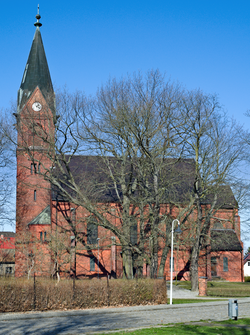Great Gaglow
|
Great Gaglow
Gogolow City of Cottbus
Coordinates: 51 ° 42 ′ 52 ″ N , 14 ° 19 ′ 30 ″ E
|
|
|---|---|
| Height : | 91 m above sea level NHN |
| Area : | 4.6 km² |
| Residents : | 1443 (Apr 30, 2020) |
| Population density : | 314 inhabitants / km² |
| Incorporation : | October 26, 2003 |
| Postal code : | 03051 |
| Area code : | 0355 |
|
Location of Groß Gaglow in Cottbus
|
|
Groß Gaglow , Gogolow in Lower Sorbian , has been a district of Cottbus with around 1500 inhabitants since it was incorporated on October 26, 2003 . Before that, the community belonged to the Spree-Neisse district .
history
Great Gaglow was founded by Slavic tribes around 600 AD. According to Götz Frh. Von Houwald (Die Niederlausitzer Rittergüter) , Groß Gaglow - like the neighboring Klein Gaglow - was a knightly enclave in the middle of the Brandenburg rule of Kottbus and seems to have been part of Brandenburg and one of the Niederlausitzer (Bohemian or Saxon) Lehnskurie alleged to have been divided, which was only integrated into the Kottbuser Kreis in 1815 and had previously belonged to the Spremberg district.
In 1466 at least the Brandenburg part of Groß Gaglow, like Klein Gaglow, was owned by Siegmund and Hans von dem Berge. The respective feudal sovereignty went across the village. After that the village seems to have disintegrated under different owners. The von Beier (Beyer), the von Zabeltitz, but also since 1570 the von Pannwitz, who were to be located there until the middle of the 18th century, owned a share. The last Pannwitz owner was Major General Wolf Adolf von Pannwitz, who sold Gross Gaglow in 1730 for 9,200 thalers to his sister Martha Elisabeth. Martha Elisabeth was married to the Electorate Colonel Sergeant Heinrich Wilhelm von Köpping. In 1752 she sold Groß Gaglow to Margarethe von Sonntag, née von List, after which the property came to the von Massow family in her second marriage and later to Carl Albrecht von Görschen in 1788.
In 1844 the village of Groß Gaglow had 45 residential buildings with 298 inhabitants. At that time the manor was owned by NN Scheibner. But Carl Emil Malin was mentioned as early as 1856. He was a son of the royal medical council and doctor of Prince Pückler-Muskau, Dr. Karl Malin. Her husband Richard Detering seems to have come into possession through Carl Emil Malin's daughter, Elisabeth Detering. Later Margarethe Freifrau von Kittlitz is named as the owner of the remaining property Groß Gaglow and for another part the Brasch family. The latter appears as the owner in 1929. From 1930 until the Nazi seizure of power in 1933 was in large Gaglow under the direction of Martin Gerson , the Jewish agricultural work GmbH , a settlement project, the 820 morning included country and as part of the restructuring was intended for agricultural education of Jewish youth.
In 1957 a horticultural production cooperative (GPG) was founded in Groß Gaglow . From this, today's horticultural company Floralia emerged.
economy
In Groß Gaglow there is the "Lausitz Park", a shopping center with a variety of shops and fast-food restaurants. There are also several car dealerships and a multiplex cinema ( UCI-Kinowelt ) in Groß Gaglow. Furthermore, Groß Gaglow has its own volunteer fire brigade , which is sponsored by the Cottbus professional fire brigade .
population
For his statistics on the Sorbian population in Lusatia, Arnošt Muka determined a population of 462 inhabitants for Groß Gaglow in the 1880s, of which 412 were Sorbs (89%) and 50 were Germans.
Great Gaglow in Literature
Groß Gaglow plays the leading role in Esther Freud's autobiographical novel Sommer in Gaglow (1998). The author, a great-granddaughter of the founder of psychoanalysis Sigmund Freud and daughter of the painter Lucian Freud , tells the story of the young Englishwoman Sarah who goes in search of her German ancestors.
Web links
Individual evidence
- ↑ residents by district. In: cottbus.de. City administration Cottbus - Citizen Service Department, April 30, 2020, accessed on June 12, 2020 .
- ^ Changes in the municipalities in Germany . StBA, see 2003
- ↑ Ernst Tschernik: The development of the Sorbian population . Akademie-Verlag, Berlin 1954, p. 72 .
- ↑ Susanne Rost: Nobody in Groß Gaglow can remember the Freuds . In: Berliner Zeitung , November 5, 1998, p. 29; Book review for summer in Gaglow



